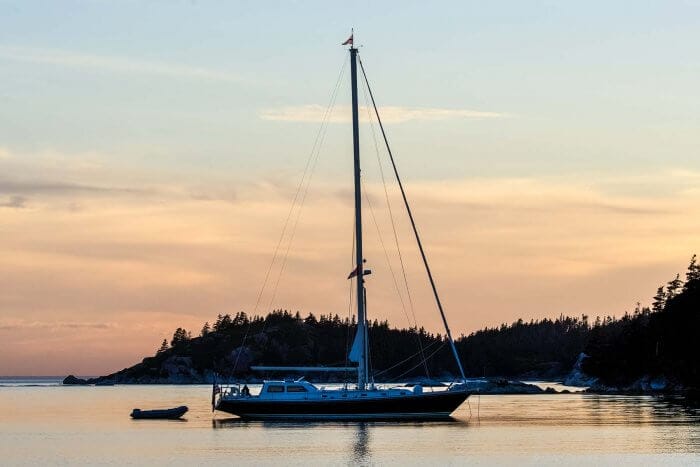
After long and steady progress, from Pèlerin’s 2015/16 winter quarters at Deltaville in the Chesapeake Bay to Nova Scotia, the boat, Louise and I were really going well.
There’s an underlying rhythm to a cruise when the boat is behaving and the weather is playing ball, and you settle into a steady groove that feels unstoppable. And that’s how we felt—ready to face anything. Newfoundland or bust!
We had known all along, though, that we’d be taking a break in the middle of the season to fly back to the UK for my son’s wedding. Unable to source a suitable mooring on which to leave Pèlerin during the three weeks of our absence, we opted to haul her out and leave her safe on the hard at East River Marine (now East River Shipyard), where John and Phyllis store Morgan’s Cloud in winter. At least that way we knew she’d be safe and sound and we could enjoy the festivities without any worries in the back of our minds.
Shattered Hopes
And, having conducted a fairly thorough re-fit schedule at Deltaville, including replacing all of the rudder bearings, we looked forward to a trouble-free season…but that was to prove a vain hope.
We still had some play in the steering and it seemed to be getting steadily worse, so I set about tracking down the source of the problem before we left for the UK. Eventually I identified the cause. There was movement in the bottom section of the steering pedestal where the actuating arm exits the bottom mounting.
A quick call to the great Cliff Mogridge of Winch Servicing in the UK, master of all Lewmar equipment, confirmed that either the bottom bearing was moving inside its mounting, or the bearing itself was breaking up. Yikes!
The question was, did we need to fix it now or would it last until the end of the season? The answers to which were simple and short: yes and no.
It wasn’t going to get any better and, if it failed, well it would do so at the worst possible moment and the steering might lock solid. So we got on with the business of sourcing the parts.
It’s Seldom As Easy As It Looks
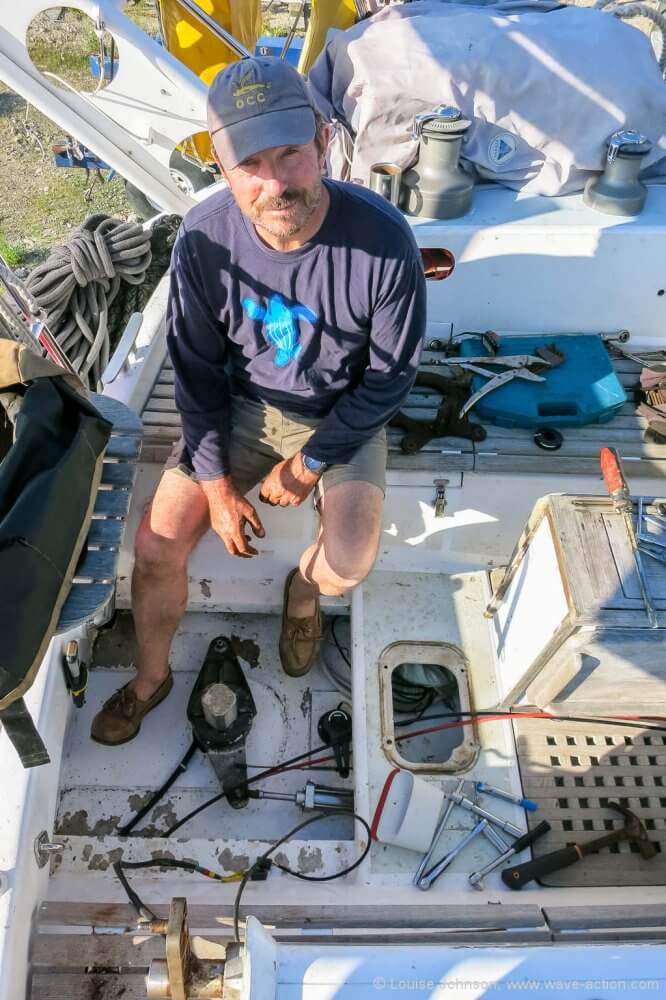
The moment I got back from the UK, out came the toolkit. I’d got the bearings and an exploded diagram of the pedestal, so I knew what to expect, and Cliff had briefed me on how to go about it.

It was no five-minute job, though, and there was plenty of swearing over seized fastenings and scraped knuckles, but eventually the bearing was out and ready to make the short trip to the workshop, where boatyard manager Donny and his great crew of guys were waiting to help me sort it out.
By now it was obvious that we’d done the right thing. What had felt to be relatively benign play when the steering was all set up, was far worse once disconnected, and the gritty feel of the shaft as it turned suggested that the bearing was well on its way out.
If It Was Easy, Everyone Would Be Doing It
However, when it came to pulling the shaft, what should have been a simple task was made onerous by the fact that the actuating arm was welded in place, so before we could even start to pull the shaft, we had to mark the position (so that it could be re-installed in exactly the same place) and grind back the weld to remove the arm. Then we could remove the bottom bearing in its housing and pull the shaft out at the top.
With the blessing of a well-equipped workshop, all of this was achieved without major trauma—you wouldn’t want to have to do this on your own in a remote bay—and we soon had it all apart. The new bearings fit fine and were soon glued in place with a special heavy-duty Permatex compound, and we were off to the welder to re-fit the actuating arm and begin the re-installation.
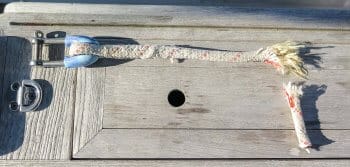
Ten days after we got back from the UK we were finally ready to launch, with our rhythm well and truly shattered. As if to reinforce the point, as we crossed the bay to Morgan’s Cloud‘s Base Camp to tidy up all of the loose ends, the main halyard snapped (again) and we knew we faced an uphill struggle to get our mojo back for the second part of the season.
By the way, our next boat is going to have a tiller.
Base Camp
Tucked away in a well-sheltered arm of Mahone Bay is Base Camp, from where John and Phyllis have set off on many adventures in Morgan’s Cloud. With her alongside the wharf as final preparations took place for their late-summer cruise, we profited from her huge mooring and began finishing off the jobs left over from the steering issue.
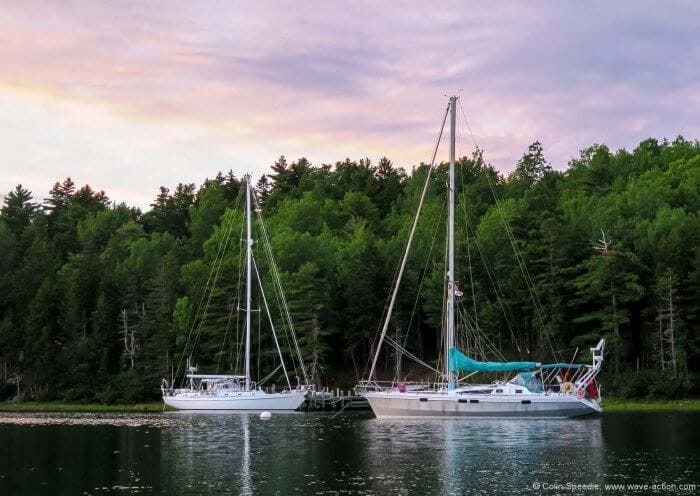
But it was hard to buckle down with so many distractions—at least when on deck—as deer, a bald eagle, ospreys, loons, and cormorants regularly appeared.
Some Visitors are Welcome and Some Not
Now, the deer and the bald eagle were very welcome, the osprey that sat on our masthead instruments and bent the wind speed and direction arm less so, and the cormorant that defaced our deck not at all.
But the strange chatter and cries of the loon on a foggy night were amazing, strange and unearthly. It was a good job we knew the source of the noise or we’d have been truly unnerved.
Finally, We’re Off
Well stocked up thanks to John and Phyllis’s help, we finally began our (now) late-season cruise. As we carry a spare halyard we could keep moving, but we planned to get a replacement as soon as possible, as the spare (in 12 mm/.5″ Dacron) is on the small side for a hefty boat like Pèlerin.
By the time we got offshore in a bit of a breeze, however, it became clear that we’d have to bring the replacement forward, as the halyard stretched alarmingly. Having used Spectra, Technora and Kevlar lines for many years, I’d forgotten just how much Dacron stretches—perhaps as much as 18″ (46 cm) in our 120-foot (36.5 m) halyard.
So off we set towards Halifax to sort it out. Yet more delays. It was beginning to feel like we were glued to the bottom.
Always Another Anchorage in Nova Scotia
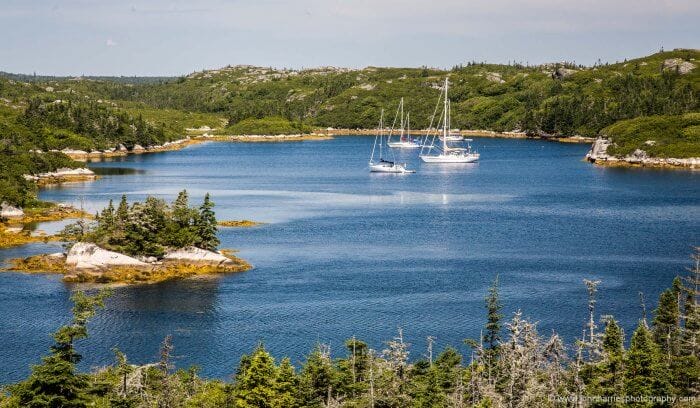
On the way we decided to stop off and visit Rogue’s Roost, one of the ‘must see’ anchorages along this stretch of coast. Of course, one of the problems with such places is that everyone else must see them too.
And so it was—the place was packed and there was no comfortable room for a boat our size. So we found ourselves a quiet spot in a corner of Cub Basin, just around the corner. With masses of space and far fewer boats this made for a peaceful stop. Though the pilot book we were using had scant information on this anchorage, so we had no information on the makeup of the bottom, the anchor seemed to bite immediately when we set it.
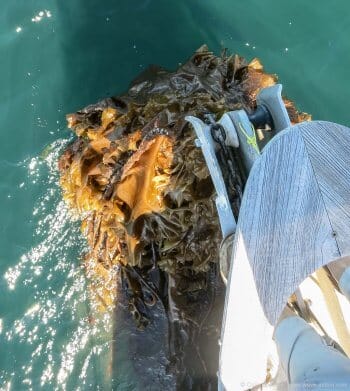
During the night the wind went round and the chain grumbling as we swung to the new direction spoke of boulders on the bottom. I made a mental note to shift to another corner of the anchorage in the morning—which is when we got a slight surprise…
This was by no means the first time I’d seen a ball of kelp this big. Thoughts of old favourite anchorages like Canna and Rum in Scotland immediately sprang to mind, including one night in the latter anchorage many years ago.
Kelp Can Be Tricky
Anchored by a 100-kg/220-lb Fisherman aboard a big gaff-rigged ketch, we’d felt ourselves immune to the solid gusts rolling down off the hills and slept like babes in the wood.
But the surprisingly different view from the deck the next morning told another story. We hadn’t been anchored at all, just moored to a gigantic ball of weed, and we had simply dragged at a snail’s pace across Loch Scresort, fortunately without anything solid interrupting our progress.
Now, as a result of such occurrences, Lou and I are fastidious about digging the anchor in, and in Cub Basin we had been as thorough as usual. The enormous ball of kelp had held us firm at over 2000 RPM astern, leaving us confident that we were firmly anchored. And we hadn’t dragged an inch according to the plotter and the anchor alarm hadn’t gone off. Just as well for us that the wind had stayed light.
But knowing that you have to expect the unexpected when you stray off the beaten track, we accepted this reminder with gratitude and thanked the Lord that we still seem to have that indispensable ingredient for this wonderful life—luck.
You Pick Yourself Up…
But it was still a slightly demoralized crew that limped round to Halifax to lick our wounds and try to source a new main halyard. Which is when the sun came out again.
As we made our way up to the anchorage off the Armdale Yacht Club, I was fretting over a niggling problem with our windlass and hoping we could find a mooring and buy the time to sort it out. But being August the moorings were full. We were just about to anchor when a Boston Whaler approached and the kind skipper offered us the use of her mooring—perfect.
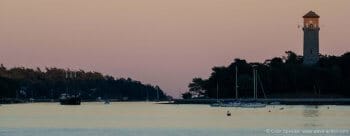
The following morning I settled down to work and the windlass problem proved simple and easy to fix.
And phoning around we sourced the new Spectra halyard and by the next day it was safely aboard. We motored down to the Royal Nova Scotia Yacht Squadron dock and crane where their rigger Paul and I soon had the new halyard rigged and ready to go.
On The Road Once More
That night, back at anchor at Armdale, the full moon lit up the reach down to the Atlantic like a magic carpet beckoning us back to the open sea, reminding us that even views from a city can be beautiful. We were ready to get back on the road once more.

And so it goes. Dick
Quite! Colin
I’ve often admired the innovative and sexy design of the Ovni yachts, but the rudder arm welded to the shaft!? Yipes, that doesn’t sound like a good idea. I sail an American boat, a J42, that certainly has its shares of mysteries and problems, but the whole thing can be taken apart with a screwdriver and a crescent wrench, which I have found both admirable and practical. Your point that cruising is often difficult, discouraging, uncomfortable and a frustrating exercise in extreme problem solving is very well taken, and not something that many people understand.
Hi Reed,
You bring up a terribly important and hard to quantify point: can your boat be taken apart with a few hand tools, and, I would add, can it be done repeatedly. I can’t count the number of times I have taken (the headliner etc. etc.) apart over the decades. Little is more frustrating than to take something apart and have the materials be so thin that the screws won’t seat or strip out when putting back together. And then there are rivets, which certainly have their place, but are often a “quick & dirty”.
My best, Dick Stevenson, s/v Alchemy
Hi Dick
again, indeed. We carry a very comprehensive toolkit (as I know you do) with every specialized tool we might need and some that we might not. I reckon that I can fix just about anything bar an engine rebuild, although I could certainly do a top end rebuild.
As you suggest, the bane of working with older boats is often the fasteners that were simply fixed to weak materials and/or in the wrong metals and so can’t be removed or simply shear off leaving you to start again from scratch.
Boatyards seldom build boats with the owner in mind – and certainly not owner number 4 – although there are honourable exceptions.
Best wishes
Colin
Hi Reed
the weld is on the shaft off the steering where it exits the steering box, not the rudder stock – you can see the actuating arm in the foreground of the pic of me with the steering apart. This is standard on Lewmar steering systems although I wish it wasn’t….
In fact, the Ovni’s are pretty simple to maintain, if not agricultural in some places – which, actually, I count as no bad thing – complicated seldom works in remote places!
Best wishes
Colin
Hi Colin.
Nice story. It gives me a smile, party from recognition.
Hi Stein
it makes me smile now, although I don’t remember smiling much at the time. But that’s why we go, eh? Character building, they called it at my school….
Best wishes
Colin
Great Story. I love living the dream with you if only in my dreams.Tech Question re the top rudder shaft bearing. Given that the length of the short arm on the top of the rudder shaft being pushed and pulled by hydraulic ram is probably about 1/6 of the length of a tiller for the same boat, does the top bearing receive 6 times the force of that produced by a tiller doing the same work? The tiller will produce the same turning moment for much less side load however the nut at the helm, you or me, will have to work a lot harder in a blow I think
Hi John F W.
I’m not an engineer and others here are much more qualified that way, but having pondered this type of questions quite a lot, with a non educated starting point, I might be able to explain my thoughts in a way that I would understand. 🙂
Your thoughts seem to be right, I think, but there are more forces working on the rudder bearings, of course. The forces from the water or even hitting things are the major ones. As a rough estimate the forces from steering the boat has their centre about half way down the rudder. If we assume that this middle point is one metre (3 feet) below the bottom rudder bearing, and that the top rudder bearing is a half metre (1,5 foot) above the lower bearing, the force working on the top bearing is twice the amount of work the rudder actually does on the water. The bottom bearing has to counteract that exact same force, plus there the actual rudder work gets added. It gets three times the rudder work load.
These loads will normally be way higher than what the tiller or hydraulics can do, so the latter could maybe be mostly neglected when choosing steering system or calculating the strength of the bearings.
The example I used here is a quite deep rudder with rather short distance between the bearings. This isn’t unusual, but I’d prefer better ratios. If we do have better ratios, we’re still not off the hook. If the rudder hits something, it’s normally at the bottom, resulting in ugly ratios. Reversing at some speed or being pushed backwards by a wave also can make things go bad. I also think most rudder stocks are too vulnerable (thin).
I’m probably a weirdo, but I rather dislike it 🙂 when the steering doesn’t work, and I positively hate essential functions that can’t be remedied while in action. For those and other reasons, (the pleasure and usefulness of rudder feedback…!) I strongly prefer tillers rather than wheels and mechanical steering transmission rather than hydraulics. Simplicity always beats complexity.
Hi John F and Stein
The hydraulic ram in the picture is the autopilot – the other side of the quadrant is where the drag link from the wheel attaches – it’s a totally mechanical set-up and pretty much bombproof.
The rudder stock is a massive solid aluminium bar (you can see it) squared on the top for an emergency tiller. There are three substantial Ertalyte bearings supporting the stock, the bottom one being in the heel of the skeg. The bottom section of the rudder is controlled via a hydraulic ram and can be raised or lowered for ultra shoal draft or beaching. There is also an ingenious rupturable core plug in the hydraulic pump for both of the rudder and the centreboard that will burst in the event of a collision with any underwater object, saving damage to the steering and in five minutes you can pop a new one in and get going again.
I’d suggest that the loads are bearable on the rudder bearings – we replaced ours at c. 25K miles. Like Stein I prefer tillers for simplicity and safety, but our set-up is pretty good and we have the lighter loads of a wheel in strong conditions. We think it’s a good compromise.
Best wishes
Colin
Thank you Colin and Stein for your reply. I can see that the lever arm (Quadrant) used by the steering ram is much beefier than the auto pilot but not much longer (centre of Rudder shaft to centre of ram pin) Forgetting the autopilot, your picture showing the size of steering ram hi-lights my point. forgetting what is happening at various points down the shaft, the actual turning moment required against the pressure of water on the rudder is quite huge. divide that by the length of the quadrant (bolt centers ) and we get the force required to push or pull. Of course I am assuming the lever arm between your feet is the connection for the steering ram. The smaller one is the Auto pilot arm and is still connected to a Cylinder. The simple levers and moments theory I remember from my apprenticeship days but I have trouble remembering what I had for dinner Yesterday.
Warm regards. Keep up the good work
JohnW
Colin,
We also have a 435 and have been plagued by the same halyard chafe. Before our transatlantic, earlier this year, I replace our, much shortened, halyard and stitched a Dyneema sleeve over the end and that has worked so far.
Great articles!! We are following you, literally (now in Martinique), so perhaps Nova Scotia in 2018.
Frank
Hi Colin & Frank,
What is the diameter of your halyard sheaves? Frank, I would think a cover such as you describe, would help with conventional chafe, but Colin seemed to describe a too tight turning radius for the HM line as the culprit which would cause internal wear/heat and differential loading of the strands/fibers which I would not describe as chafe per se.
Thanks, Dick Stevenson, s/v Alchemy
Hi Frank, Dick
the first time that the halyard failed was due to chafe after an Atlantic crossing of 2350 miles one port tack! The halyard chafed through the outer skin on a bridge between the two shaves at the masthead, exposing the Kevlar core which failed (rapidly, I might add) due to UV. The moral of this story? Don’t use Kevlar halyards.
The second time was juts age and wear and tear, I’d guess, where the (still) Kevlar halyard simply ruptured due to the tight turn over the sheave. Kevlar apparently doesn’t like those tight turns, making it – you guessed it – the wrong choice for halyards.
We now have a rather flashy Dyneema mix halyard that is supple and easy to handle and looks like it should last for a good few years. I’ve also replaced and smoothed the bridge between the two sheaves, so – fingers crossed!
Best wishes
Colin
Colin, I now have four of those “rather flashy” Dyneema core/Dacron covered halyards, so if mine go pear-shaped, I’ll let you know. It’s an interesting point, however, that the very fact they stretch less means the same spots leading from the main headboard up and over the sheave get consistently exposed to UV and weather. Maybe a coating or a cover on the first metre up from the shackle makes sense?
Hi Marc,
I am still not convinced that UV and chafe are major determinates of halyard breaks near the shackle. With a regular eye on the area (easy to do except on long passages) one should have good warning of problems. Moreover, UV damage to outer cover, in many/most HM ropes, would not compromise strength. More to the point, and more insidious is when the turning radius is too small. Then it is internal damage, un-noticed and un-announced, that leads to catastrophic failure.
As to your suggestion, I would want any added cover to be very well executed and well matched to sheave trough size. There is many a boat that has drawn their spinnaker splice (larger diameter) into the masthead sheave only to get it jammed and then have the spinnaker halyard unable to be released.
My best, Dick Stevenson, s/v Alchemy
Hi Dick
the first time our halyard failed was after our arrival in Brazil from the Atlantic. We had suffered some chafe that had exposed the Kevlar core and although I dropped the main at one point and stitched the cover back up I suspect the damage was at least partially done by then. Kevlar has poor UV resistance – Dyneema (I’m told) is better.
The second time was certainly not due to UV exposure, but the tight radius around the sheave – perfectly fine for most applications, but not Kevlar (I’m told).
With the new halyard we’ve checked everything and it all looks good, so I’d anticipate a far longer life out of this halyard.
Best wishes
Colin
I’ve always favoured external blocks for spinnaker halyards for this reason. We are still sorting out our mainsail handling, but I think the stopper is getting retired.
Great account of your obstacles and adventures, Colin. I’m sure being in such a beautiful land/seascape must help get over the frustrations.
Your comment about your next boat having a tiller gave me a chuckle. Tiller vs wheel is a topic I’ve been researching lately, and I wonder if you could comment on the feasibility of tiller steering for French centerboarders such as OVNI or Boréal?
Much thanks,
Scott
Hi Scott
well, you know what they say: cruising = boat maintenance in paradise!
It’s always feasible to go for a tiller below, say, 40ft LOA. The loads are manageable, setting up self steering is easy with a tiller and it makes for a roomy cockpit. But if you have to hand steer for any length of time, you’ll maybe regret it.
Over 40ft LOA I think it’s very difficult (although Ive seen it done) simply due to the loads involved. As a youngster I sailed on old working boats of about that size that had tillers and I can remember one memorable Channel crossing in a middling sea that wore out four hearty 18 year olds in 12 hours! We used to rig tackles to make it easier to cope with heavy weather helm – now sell that idea to your family….
Best wishes
Colin
Interestingly, we have the best of both worlds: two-station hydraulic steering (pilothouse and aft “outside” helm) and the option to bypass the hydraulics and run a windvane on a tiller. While there’s clearly more fuss involved, for long runs the windvane is a beautiful thing to have. Steering with just the tiller, however, is best left to the Viking physique, but rigged with the right blocks, everything goes smoothly.
Hi Scott.
I’ll not attempt to fully answer your question, but since I’ve also spent quite some time exploring similar thoughts, albeit for catamarans, I feel I have a grip on the parameters we need to balance. Most of it won’t surprise anybody here, but maybe a runthrough can be useful?
The first point we need to accept is that “there is no such thing as a free lunch!” 🙂 Both wheel and tiller have important advantages and important disadvantages we can’t avoid. We just need to pick the package that fits our boat and our sailing style the best.
The tiller gives zero extra friction, maximum feel of the rudder and the boat and the most precise and rapid control of the boat. This comes with the cost that it will be much heavier work to use it if the boat isn’t balanced, the weather is heavy or the boat layout isn’t good.
The wheel will give much more friction and normally quite a bit of slack. The sensitivity and feel will be much less or none at all. Especially hydraulic systems are bad this way. Some mechanical systems, (designed like the steering of cars) can be good enough so even I could accept it. The wheel is also slower. The benefit of this lack of feel is an easier job with lower loads even in not so nice conditions.
A tiller is a much lighter total system than any wheel system, but normally takes much more space in the cockpit when sailing than a wheel. When not sailing, the tiller can be lifted out of the way and takes no space at all, which the wheel can’t.
The tiller is simplicity at its best. It does its job with just one very simple part attached directly to the rudder. The wheel, no matter which transfer system, has quite a lot of parts, normally with quite some complexity. The amount of servicing and probability of failure is way higher.
So how to conclude?
Probably first decide ones own preferences. I’m a speed and performance fanatic. The word “fanatic” is NOT an exaggeration! 🙂 I want the right conclusion to be tiller. I love every bit of the idea. Still the conclusion isn’t always that easy. Most of us sail mostly cruising and mostly rather long stretches. Mostly we’re not hand steering the boat. So we need to look at which type of self steering we want to use. Some of them are better with some wheel transfer mechanism. Others may be better with a tiller.
I want to have a system with tillers (catamaran) and a mostly mechanical self steering. Servo pendulum type wind vane using the rudders with a backup electromechanic autopilot for low wind and low courses. But I have to admit that I haven’t found a finished layout that I entirely trust, yet. My current cat has a wheel with hydraulic transfer, which I hate, but I’m not going to change it on this boat. It works. Now. That’s maybe the most important point of the whole topic?
Hi Stein
following my reply to Scott, I’d just like to say that everything you say is true, my only concern is the extra mechanical advantage with a wheel for boats over 40ft LOA (just my basic yardstick, by the way, not a hard and fast rule).
Light weight, simplicity, ease of setting up and AP or wind vane, extra cockpit space, lovely feel – what’s not to like? But if you go over the size limit significantly you’re going to end up with a long tiller and few friends after some bad weather.
Our wheel system is great, totally mechanical and had it not been for the failed bearing would have been absolutely trouble free since purchase. Really well thought out cable steering without overly long cables (the curse of many centre cockpit boats) is just as good. Hydraulic, as you say, has no feel, but is at least dependable (centre cockpits again).
There was a part of me that wanted a tiler when we built our Ovni, but I’m glad we didn’t…
Best wishes
Colin
Hi Colin,
I would second the reliability of simple cable steering. That’s what we have on Morgan’s Cloud and it has never given any trouble in well over 100,000 miles. We do replace the cables about every 25,000 miles, but that’s more from an abundance of caution than need.
And MC is a centre cockpit boat with quite long cables, but that has never seemed to be a problem.
Hi John
cable steering done right and properly maintained is a good way to go. Once the cables have stretched initially and been adjusted it’s usually just a case of regular inspection and lubrication of sheaves. I agree with your policy of regular replacement, which makes sense.
I have one concern about cable steering these days and that is that I’ve noticed some recent production boats that I have looked at have alarmingly thin cables. I’d guess that this is yet another example of the ‘product cheapening department’ making their presence felt, but it’s yet another ‘under the skin’ reason to buy a proper boat in the first place if your plans go beyond local cruising.
Best wishes
Colin
Hi Colin and Stein,
Thanks for the thorough overview. My sailing experience is predominantly on boats in the dinghy to folkboat range, where things can’t get much more simple, so hearing about your experiences is helpful. Sounds like the feedback we enjoy on smaller boats becomes much more of a wrestling match as you size up.
With the rudder post, steering gear, wind vane, and auto-pilot all coming together right in the middle of everything else at the crowded end of a cruising boat, it’s an interesting challenge to hunt for the optimal set of tradeoffs.
Hi Colin,
Since racing boats such as the Open 60´s also use tiller steering, isn´t the real limit how well the boat is balanced, rather than length? I know that the 60´s sail most of the time with NKE (or similar) autopilots, but they must also be able to be easily managed handsteering. Speculation on my part, maybe the skippers are all supermen.
Yours aye,
Bill
Hi Bill
well, it’s my understanding that the Vendee Globe boats are steered 99.99% of the time by autopilot (and they have lots of them!). I am sure they can be hand steered, but I’m not sure how long I’d want to do so. Those guys are superhuman and would probably paddle the boat around the world if they had to…..
Best wishes
Colin
Colin, the honesty with which you describe your setbacks and mistakes makes for enjoyable and educational reading. Thanks for sharing!
We like our dyneema-core halyards. I ditched the SS main halyard shackle and splice, using a bowline to create a loop just large enough for a dyneema soft shackle. Maybe I’m misguided here, but I figure the WLL (>14,000 lbs) is sufficient to handle the loss of strength at the knot. Last winter I end-for-ended the whole affair, but I could have gained nearly as much benefit by simply cutting off a few inches and retying the bowline, shifting the stress points at the shiv and the knot. My core-to-core eye splices are lousy, so if I were still using a spiced shackle I would have taken the lazy route and no nothing!
Hi Colin,
That’s an interesting way to go, but I would caution against using a bowline in dybeema/spectra halyards. What tends to happen is that over time the high modulus core creeps through the knot resulting in the low strength sheath taking all the load. Then if that fails (quite likely) the knot will slip suddenly.
Testing had shown that the only knot that will hold in Spectra is the Estar, (a variation on the buntline hitch) but even that will still allow the core to creep.
This is why rope manufactures are pretty much unanimous that high modulus line must be spliced. To do this we use what we call a Maloney Splice: https://www.morganscloud.com/2006/05/18/maloney-marine-rigging/
But any competent rigger should be able to do a good one. Definitely a place we delegation makes sense, we think.
Thanks for the feedback, John. I use the Estar knot for uncovered dyneema, but I had assumed the covered stuff would be more slip resistant. Drats! I suppose I’ll either delegate, as you suggest, or splice it myself. I can’t do the polyester-core lines to save my life, but I find myself doing more and more dyneema splices, partly because I can!
Also, there are some simple splices to integrate the soft shackle into the halyard’s dyneema core, itself, eliminating the bowline. This would make it a little more time-consuming to do pre-emptive maintenance on the halyard (shifting the stress & chafe spots), but easier than a core-to-core splice. Maybe I’ll give one of these splices a try next week.
http://l-36.com/HybridHalyard.php
Colin,
The only problem I have had with the “integrated soft shackle halyard splice” is that when the soft shackle chafes/degrades due to tight bend around the sail it is much harder to replace. I have been using 5/32″ soft shackles on small boats, Holder 20 and J22, for the main halyard and they seldom last a session of heavy use, even with a piece of dyneema chafe sleeve were the shackle passes through the head board. I have been splicing a thimble to the halyard and putting the soft shackle through and using a piece of 5/64 dyneema to keep the soft shackle from falling out. I am still debating if I will use a similar set up on my Morgan 323. I have not come up with a good way to reduce the chafe and increase the bending radius where the soft shackle passes through the headboard.
Sam, for hybrid halyard at the link in my prior post, the soft shackle is a separate, easily removed component. As for the soft shackle chafing, I wonder if your headboard is a different shape than ours (smaller turn radius) or there’s a sharp edge? I’ve not seen chafe on ours.